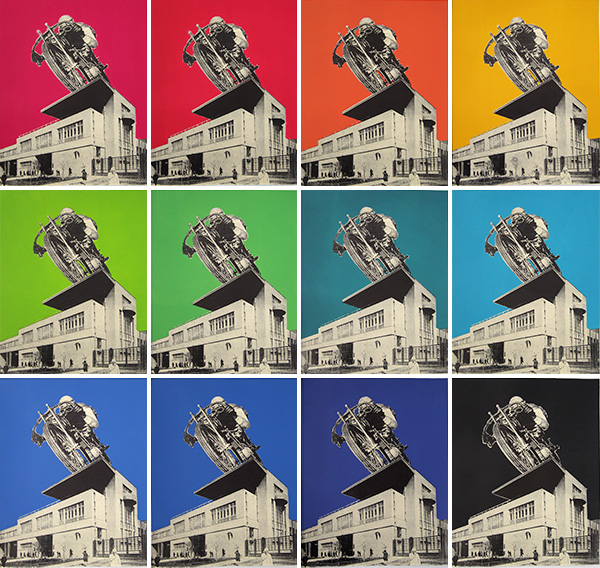Mikhail Karasik. Homage to Constructivism

St Petersburg: M.K. Publishers, 2012
53 × 42.5 cm. Edition: 10 copies. 12 compositions – lithograph in two colours printed by the artist on BFK Rives Cream paper. Unbound. In a cardboard folder covered with book cloth, silkscreen printed. In Russian and in English; translated by Paul Williams.
Homage to Constructivism is a colour suite of a single composition. The sheets, when placed together, resemble frames from a film in which a motorcyclist takes off from the enormous canopy of a building as if from a ramp.
The photomontage is made from two photographs — the racer and the Vyborg mechanized canteen in Leningrad. ‘At Racing Speed’ (photograph: Atlantik) was widely known in the USSR from the late 1920s. The picture from László Moholy-Nagy’s book Painting Photography Film (Bauhaus Bücher, 1925) first appeared in 1928 on the cover of Issue 8 of the magazine Sovetskoye Foto. A year later it was reproduced in the special Russian translation of Moholy-Nagy’s book, Zhivopis’ ili fotografiya, a volume in the series called The Library of Sovetskoye Foto. The Vyborg mechanized canteen, one of the most striking works of Leningrad Constructivist architecture, was built in
At the turn of the 1930s, during the period of large-scale reconstruction of Soviet industry, the new programme for the organisation of people’s existence was directed towards socialisation, the collectivisation of labour, leisure and daily life. Mechanized canteens or ‘meal factories’, which with the propagandistic bombast of those years were called ‘a school of public catering’, were seen as one of the first steps towards the creation of a model of the future: they were forming ‘a new type of human being’. The spacious halls of the public canteens with modern kitchen equipment, rest rooms, nurseries, a library and shower rooms, were constructed on the principle of the factory assembly line and intended to be used by thousands. They liberated the housewife from the domestic stove and cultivated a new culture and a Soviet etiquette. The country turned into an enormous building site, where the general line was ‘drawn’ by Constructivism. By the end of the ’30s everything had changed, including the narrative that went with these pictures: the ‘Racer’ became merely an example of a striking angle of view conveying movement, while the functional architecture of the mechanized canteen was condemned as formalism and leftist excesses. Speed was now symbolised by photographs of the steam engine Joseph Stalin (JS) — the most powerful passenger locomotive in Europe, reaching speeds of up to 170 km an hour. In architecture Neo-Classicism had won the day, while the Soviet authorities’ highest achievement in the organisation of collective labour and daily life had become the penal camps.

